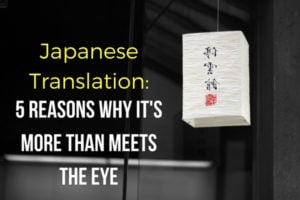Japanese is a rich language with an ancient history and global clout to match. It's the language that gave us anime and the haiku. It's also the language of the world's 3rd largest economy. Want to learn more?
Here are five reasons why there's more than meets to the eye to the Japanese language and Japanese translation.
Japanese has approximately 125 million native speakers.
Although the country is only about half as big as the state of Texas, Japanese is the 9th most spoken language in the world. As you might expect, most native speakers are in Japan. But not all of them.
For example, 12% of Hawaii residents speak Japanese. There are 436,000 Japanese speakers living in the US, with the largest communities in California, Washington, and Oregon. As a result, US companies doing business in those states may need to translate some of their business content into Japanese to reach their customers and to ensure compliance in some industries.
Did you know? 3.2% of all Internet users speak Japanese, making it the 6th most common language online.
The Japanese language has many different ways to communicate politeness and social status.
In English, "please", "thank you," "sir," and "ma'am" will get you a long way. In Japanese? Not so much.
There are 3 main categories of honorific speech in Japanese:
- sonkeigo (尊敬語), or "respectful language"
- kenjōgo (謙譲語), or "humble language" (or "modest language")
- teineigo (丁寧語), polite language.
These categories are distinguished by different vocabulary, word endings, and alternative verbs.
Want your content to connect with readers? Start by addressing them appropriately. Our native-speaking translators will help you get the nuances right!
Japanese uses 4 systems of writing.
According to Wikipedia, the Japanese writing system "is often considered to be the most complicated in use anywhere in the world."
What makes it so complicated? Well, to start with, there's four types of writing to contend with:
- Kanji, characters adopted from Chinese. There are thousands of these. Japanese schoolchildren learn 1,006 of them in elementary school alone!
- Hiragana, a syllabary with 46 base characters.
- Katakana, another syllabary with 48 base characters.
- Romaji, which is Japanese written using English script, mainly for the benefit of foreigners.
Japanese translation warning: Japanese script takes up more room than Latin.
When translating from English, the Japanese translation typically requires more space both vertically and horizontally, even if the character count goes down. This is because the Japanese script is more intricate than the Latin alphabet. Therefore, more space is required between characters to keep the text readable. Japanese characters also tend to be taller.
If you're working on a document or a website and you plan to have it translated into Japanese, use a layout that's flexible enough to accommodate the extra space. You'll save time and money!
Japanese is a subject object verb (SOV) language.
English, on the other hand, is subject, verb, object. Most English sentences (though certainly not all) are structured like this: "She sees a dog." In Japanese, sentence structure is more flexible than in English, but most sentences tend to be structured like this: "She a dog saw."
Japanese is a beautiful language that differs from English in some intriguing ways. But don't let its complexity scare you! VIA's team of native-speaking Japanese translators can handle anything from marketing copy to complex legal and healthcare translation.
For example, VIA helped Webtrends create a localized version of their website, one of their key analytics products, and online lessons for potential customers. Download the case study here.
Want to learn more about VIA and our award-winning translation process? Give us a call at 1-800-737-8481 today!

